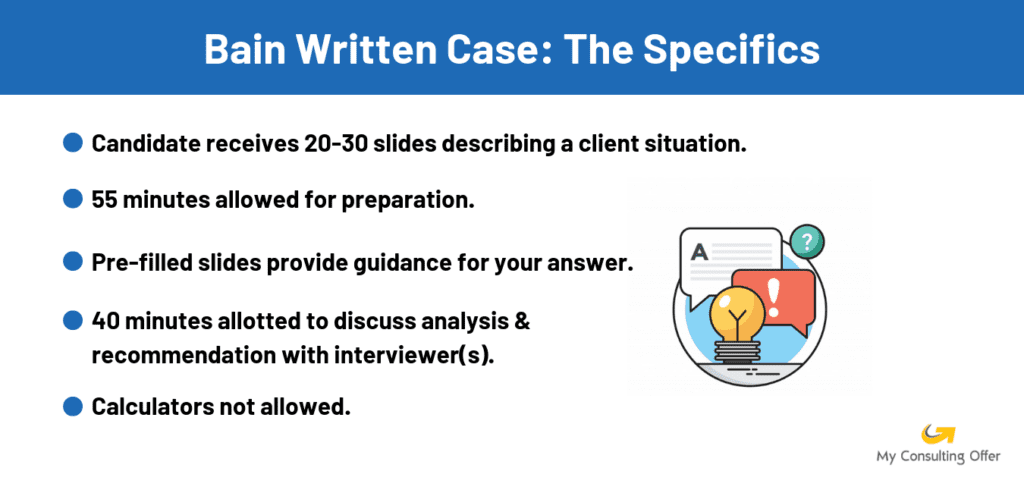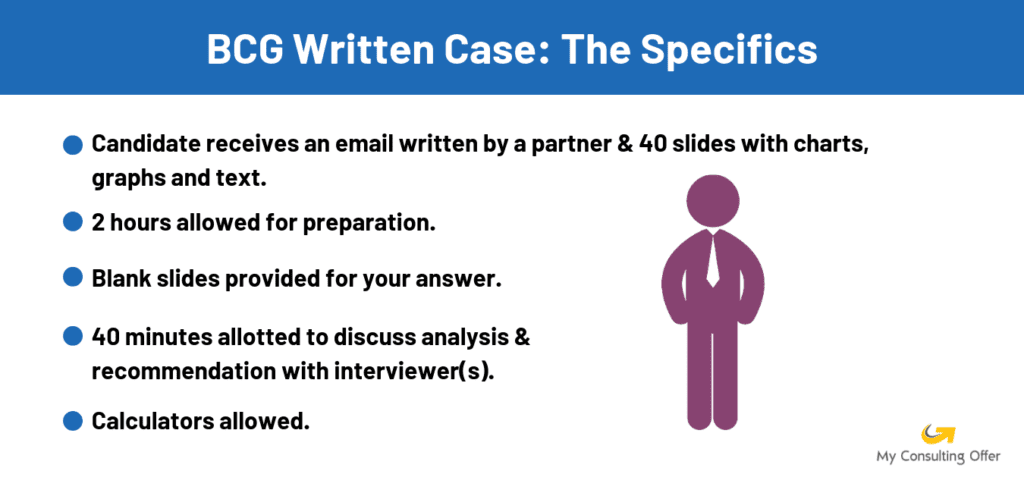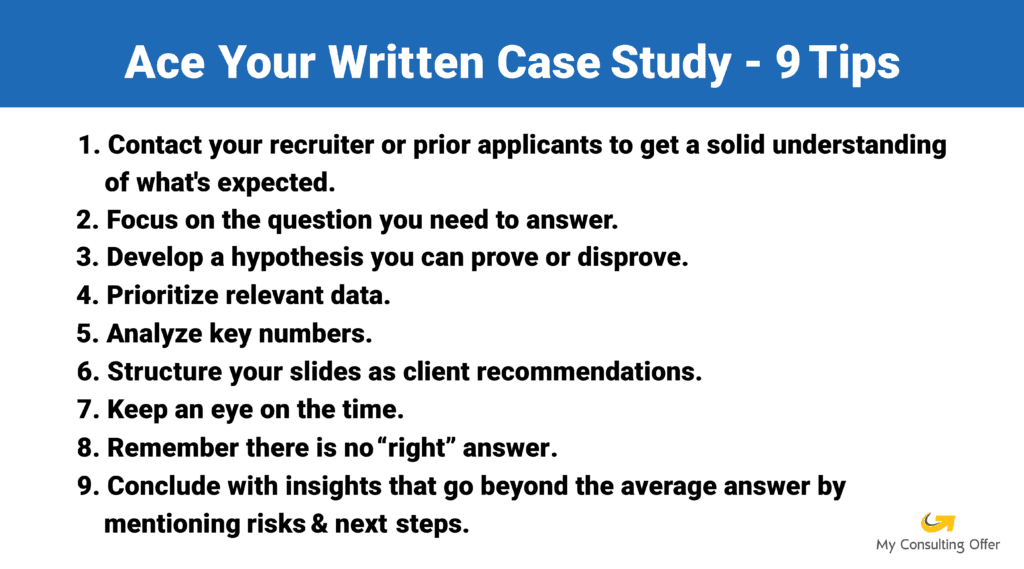


Rebecca Smith-Allen
Former McKinsey Engagement Manager
The written case interview is less common than the typical case study interview, which is conducted one-on-one with an interviewer. But even top firms like Bain and BCG use them in some geographic regions, so you’ll want to be prepared for them.
The good news is that the written case is just a different form of the case interview. If you’ve been preparing for the case study interview, then you have the foundations to pass the written case as well. But the things you need to do to ace a written case are not exactly the same as a normal case.
In this article, we’ll provide:
- An overview of the Bain and BCG written case interviews,
- Tell you how they’re structured,
- Share our 9 tips on written case study interviews, and
- Tell you how you should prepare for these types of cases.
Why Do Bain and BCG Use Written Case Study Questions?
Some people are great at talking. Some people are great at writing. To succeed in consulting, you need to be pretty strong at both.
Bain and BCG use written case study interviews to make sure they hire consultants that can absorb key facts whether the data is provided in a conversation or in writing. They’re also looking to see whether you can go through large amounts of data quickly and whether your written communication is effective.
In a written case interview, your interviewer is still looking for the same key problem-solving skills:
- Can you frame the question that needs to be answered?
- Can you drive the discussion of the options open to the client?
- Can you do the quantitative analysis required to support your problems solving?
- Do you display good business judgment in your recommendation?
Bain Written Case Study Questions — What to Expect

Your written case study at Bain will start with you receiving 20-30 PowerPoint slides that describe a client’s situation.
You’ll have 55 minutes to read the slides, pull key data and insights from the material, and handwrite missing data into 3-5 slides provided to you.
You’ll then meet with one or more Bain interviewers for about 40 minutes to discuss your analysis and recommendations. During the first half of this time, you’ll present your slides. During the second half, your interviewer will ask questions.
A warning!
Your interview may challenge your assumptions or conclusions. This does not necessarily mean that you got the “wrong” answer. It only means that your interviewer wants to test whether you can support your recommendations when pressed.
Over the course of a 6-month study, things change. Your interviewer wants to know that when they do, you’ll be able to react to the situation in a way that shows your insight into the problem, not panic.
As mentioned above, you’ll get a few slides that contain some pre-filled information but they are not complete. These slides might have a title and be otherwise blank. In this case, you’ll be required to find the appropriate information to support the title and to create the page.
Alternatively, these slides might have graphs and tables that require data to be filled in. In this case, you need to find the information required and do the appropriate calculations to provide the missing numbers.
The good news is that because you’re provided direction on what belongs on the page, you don’t need to create a storyline for the presentation or decide how many pages to present.
During the Bain case interview you are not allowed to use a calculator.
The quantitative problems in the written cases are not complicated, but your interviewer is looking to see that you can do basic analysis correctly.
Which Candidates Get a Bain Written Case Interview?
Not all Bain recruits are given written case interviews. They’re primarily used in the European and Asian offices, not in North America. They’re very common in Bain’s Greater China offices.
Any recruits—undergraduates, business school students and people looking to transition to consulting from jobs in other fields—could all be given written case interviews. People applying for summer internships could as well.
Bain uses written cases in final round interviews, not the first round. The final round interviews will include a fit interview as well as a written case.
The written cases count as much as “normal” cases do. They can involve any industry and any type of client problem
BCG Written Case Study Questions — What to Expect

The BCG written case question is structured like an email written by a partner at the firm. In the email, the partner asks you to answer 3-4 questions. He or she wants you to prepare slides that could be used to discuss the issues with the client.
Along with the email, a slide packet of about 40 pages will be provided. These slides will include data charts, graphs, and text.
You’ll have 2 hours to go through the information you’re provided on your own and create the slides. However, with 40 slides of dense information in your hands, you could easily spend the entire 2 hours just reading and not have anything to show your interviewer.
Use your time efficiently, skimming for information that’s directly relevant to the questions you were asked to answer.
Your packet will include a few blank pieces of paper to use to create the slides that answer the partner’s question. Because these pages are blank, you’ll have to decide how many slides to create and how to structure them. This puts a lot more pressure on you to decide how to shape the story about the solution to the client’s business problem than in the Bain written case.
A couple more small but important points:
You’re allowed to use a calculator during the BCG written case interview.

You’re not allowed to write on the slides you’re given because BCG uses these same slides with other candidates. This can be challenging because you won’t be able to make notes on the slides you’ve pulled data from in case you want to go back and reference it.
After the 2 hours working on your own, you’ll have a 40-minute discussion with an interviewer.
- During the first 20 minutes: you’ll present your slides to the consultant.
- During the second: they’ll ask you questions about your analysis and conclusions.
Which Candidates Get a BCG Written Case Interview?
BCG does not use written cases in all of its locations. We’ve heard of BCG using written cases in U.S. offices, Russia, Sweden, the Netherlands, and South Africa.
When they do use written cases, it’s always in the second round of interviews and you will know well ahead of time to prepare for them, so no need to worry if it will be a surprise come interview day.
What Are the Differences Between the Bain and BCG Written Case Study Interview Assessments?
The Bain written case is shorter both in terms of the number of slides you’ll need to sort through for information and in terms of the time you have to work on your own.
The Bain written case also provides slides that are partially filled in, which you will need to complete.
You are not allowed to use a calculator on the Bain written case interview but you are allowed to on the BCG written case interview.
For the BCG written case, you’ll have more slides to sort through and more time to do it. You’ll be provided with blank slides on which you can provide your answers to the questions from the partner’s email.
Are Written Case Questions Different from Normal Cases?
Written cases are similar to normal cases. The interviewer is still assessing how you structure and solve a business problem.
There are 4 key differences though:
- There’s too much information. The 20-40 slides you’re given will provide more information than you need. Sift quickly through the data to find the information most relevant to the question you need to answer.
This tests a skill that is directly applicable to real-world consulting. Clients have tons of data, but if you ask for everything that could possibly be relevant, you’ll take so long answering the question that it could be irrelevant by the time you reach it. You need to sort through what is worth your time and what to set aside.
- You’ll feel time pressure.
 Because you get more information thanyou need, you’ll have to prioritize even more than in a normal case. If you spend time on every slide, you won’t have the time you need to write your recommendation.
Because you get more information thanyou need, you’ll have to prioritize even more than in a normal case. If you spend time on every slide, you won’t have the time you need to write your recommendation.
Time pressure is also an important part of real-world consulting. Every week a consulting team is on a case costs the client a lot of money. For the study to be worthwhile, the team needs to be efficient.
- You’ll need to focus on your recommendation. In our article on Case Interview Examples, MyConsultingOffer.org founder, Davis Nguyen, discusses the 4 key parts of the case interview, the opening, the structure, the analysis, and the closing. In written cases, focus on the closing or recommendation for the client. You’ll discuss other aspects of the case when you meet with your interviewer.
- You’ll need to write effective slides. Strong and concise writing is important. Your written recommendations should only be 3-5 slides.
(You’ll be free to determine the number of written pages you want to use for BCG written cases. For Bain written cases, use only the partially-filled slides provided to you.)Don’t use the slides to describe how you did the work.
Don’t document every step you went through to reach your conclusion or every calculation you did. Use headings that speak to the steps you recommend the client takes. On graphs or charts, headings should speak to the implications of data, not simply regurgitate what the chart shows.
![]() Chart Title: The company sells more of product X than product Y in region 1.
Chart Title: The company sells more of product X than product Y in region 1.
![]() Message Heading: The success of product X in region 1 suggests that it would be the strongest product to launch into region 2.
Message Heading: The success of product X in region 1 suggests that it would be the strongest product to launch into region 2.
Effective written slides are important because they focus the discussion of the group of business leaders around a table and drive the conversation towards a decision.
What Written Case Study Questions Tell You About the Job of a Junior Consultant
Look at the structure of the Bain and BCG written cases:
- You get an email from a partner who’s not available to answer questions when you start your work, or
- You’re given a huge pile of data with slides that roughly outline the analysis to be done,
- You’re responsible for quickly finding the key data, doing the analysis and creating the PowerPoint slides for the client meeting.
This is actually a fair representation of the work new consultants do at any of the top consulting firms. Partners work with multiple clients so they will not be around to tell you exactly what to do and how to do it.
A great consultant will work independently finding and analyzing data and creating slides.
Because of this, a written case is a great second round interview. It will tell your interviewer a lot about how well you’ll perform in the job. It will also give you good insight into what the job is like.
Written Case Study Interview Examples
- Which of the client’s products are the most profitable? Are there new markets the client could serve with these products?

- Which market should the client enter? Why is this market attractive?
- What would the competitive advantages and disadvantages of the client’s product be in the new market?
A written case study question could focus on any industry and any geographic region, just like a normal case study can.
Writing PowerPoint Slides – The Best Approach
In our intro page on Case Study Interview Prep, we talk about the 4-part process for answering a case.
The one time we don’t recommend you use this approach is on written case study questions.
Why?
If you go through the 4-part process for answering a “normal” case in your PowerPoint slides, you’ll spend too much time on less important topics and not enough on your recommendation for the client. Instead, turn the structure around and start with your conclusion or recommendation. We recommend your written slides follow the following 5 R outline:
- Recap the question.
- State your recommendation.
- Provide the reasoning behind your recommendation.
- Outline any risks to your recommendation.
- Retain the client by suggesting next steps.
Below, we’ll provide more detail on each point.
1. Recap the question.
This is a simple step but it ensures that everyone is focused on the same goal. Don’t skip this step even though it seems obvious.
2. State your recommendation.
 If you start with providing facts, the natural inclination of a listener is to jump to the conclusion they think you are heading for. Their guess might be right, but it might also be wrong, requiring you to spend time talking about a course of action you don’t think is suitable.
If you start with providing facts, the natural inclination of a listener is to jump to the conclusion they think you are heading for. Their guess might be right, but it might also be wrong, requiring you to spend time talking about a course of action you don’t think is suitable.
The best way to move the discussion forward efficiently and keep the interviewer (and your future consulting clients) focused on what you’re saying rather than on guessing what’s coming next is to simply lead with your answer.
3. Provide the reasoning behind your recommendation.
Now is the time to show that you thought through your solution and crunched all the necessary numbers. Create a slide with the data behind each supporting argument.
4. Outline any risks to your recommendation.
Many recruits can do steps 1-3. Their computations are correct and they come up with a reasonable recommendation. What will set your written case study answer apart?
Going above and beyond the average answer. One way to do this is by outlining risks.
Whoa, you might say, if I talk about risks won’t my answer sound weaker?
No.
First of all, any senior business leader knows that all business decisions come with risks. There is risk in doing nothing because your competitors will act faster and come out with better products or better marketing plans.
There is also risk in acting fast because you might find that with imperfect information, you didn’t make the best possible decision.
But knowing what risks are the most relevant to a business situation will help the client minimize the risks or avoid them altogether.
5. Retain the client by suggesting next steps.
Like outlining risks, suggesting next steps is a way to go beyond the basic answer most recruits provide. In particular, you want to show how you can help with the next steps.
Consultants make money by providing support to their clients. If there are ways that you can help the client with the next stage of the project, that will also create more interesting work for you and continue to help your client’s business.
What Does this Approach to Writing PowerPoint Slides Look Like?
- 1st slide: Client Should Take Recommended Action for the Following 3 Reasons.
- 2nd slide: Outline reason #1. The slide should provide charts or data that support the statement.
- 3rd slide: Outline reason #2. The slide should provide charts or data that support the statement.
- 4th slide: Outline #3. The slide should provide charts or data that support the statement.
- 5th slide: Recap the Recommendation – emphasizing benefits but touching on risks and how the consultant can help with next steps.
9 Tips for Solving Written Case Study Questions

1 | Contact your recruiter or prior applicants to get a solid understanding of what’s expected. Will you be expected to complete slides provides or write slides from scratch? How long is the preparation time, presentation time, and Q&A time? Who will you be presenting to?
2 | Focus on the question you need to answer. If you start with the end in mind, it will help you zero in on the information that will drive the answer to the client’s question. It will also help you discard irrelevant facts.
The question must be clear in your mind before you go through the slides. The question may be stated in the way that is nebulous or strategic. If so, you should reframe it into something more straightforward that can be answered with data.
Write your reframed question down.
You may think that you will clearly remember the question, but all the information on the slides will look important. Keep the question close to hand as you skim through the information on the slides.
3 | Develop a hypothesis you can prove or disprove. A strong hypothesis will keep you focused on finding data and anecdotes that are relevant.
4 | Prioritize relevant data. Not all facts or slides are equally important. Focus on the key issues and avoid getting lost in the weeds.
5 | Analyze key numbers. Figure out what data is important for the decision the client must make and perform necessary calculations. Ignore the rest of the data.
6 | Structure your slides as a client recommendation. While the “normal” case has 4 stages: the opening, the structure, the analysis, and the conclusion, your written case study answer should start with the conclusion or recommendation.
What should the client do?
Don’t waste time describing the tables you created or the calculations you did if they have no bearing on your recommendation. Everyone assumes you can do the math. What they care about is the “so what” that comes out of the math.

7 | Keep an eye on the time. It’s important to make sure you have enough time to write your slides. Allocate the time you’re given to skimming the slides provided for information, doing necessary calculations, and drafting slides. Make sure you don’t run over on reading slides.
Optimally, you’ll want to leave a few minutes to think through how you’ll present the slides to your interviewer as well.
8 | Remember there is no “right” answer. The key to this interview is to make a well-reasoned recommendation and have a rich discussion about how to achieve results for your client.
Everyone gets nervous during an interview, but second-guessing whether your recommendation is right or wrong will only waste time. Instead, focus on making your argument for the recommendation you’ve chosen as strong as it can be.
9 | Conclude with insights that go beyond the average answer to the case. As mentioned above, most recruits will get the math right and present a reasonable recommendation. Go beyond this by highlighting risks that the client should be aware of as they implement your recommendation and ways your consulting team can continue to assist the client through the next steps.
Risks and next steps are mentioned by few candidates and will set your answer apart from the rest.
How Should Candidates Approach Written Case Study Practice?
Learn to Write Presentations Like a Consultant.
The key to writing presentations like a consultant is to tell a story. Use the 5R framework from above to create your story.
Start with your recommendation to the client. Back up your recommendation with supporting arguments and the data that lead you to them.
Use message headings rather than titles that just repeat the data in a chart.
![]()
Chart Title: Product C has higher sales than products A or B.
![]()
Message Heading: Product C’s success in the domestic market indicated that it is the best product to launch into the new market.
Practice your consulting math skills.
If your basic math skills are rusty and making you nervous, that will slow you down in any case interview. Rusty math skills can be particularly problematic in a written case because there will be no interviewer to coach you that you’ve made a mistake until your slides are already written. Bad math could cause you to create slides with the wrong recommendation and that would be difficult to recover from.
See our page on Case Interview Math for more information on what types of calculations case study questions typically ask for and tips on how to practice.
Preview written case interviews.
Just knowing what to expect in a written case interview is a huge advantage. Take a look at the resources listed in the next section. Reviewing a couple of BCG or Bain written cases will make you feel more confident and allow you to answer the question faster once you’re in the interview.
Additional Resources on Written Case Study Questions
For more information on written case study questions, see:
This Bain video or BCG’s Guided Consulting Cases.
In this article, you’ve learned about both the Bain written cases and the BCG written cases. You’ve learned what the format is, what to expect and how to prepare for these written case study interview questions.
We hope you ace that written case!
Still have questions??
If you have more questions about written case interviews, leave them in the comments below. One of My Consulting Offer’s Bain or BCG case coaches will answer them.
Other pages people preparing for written case study interviews found helpful include:
